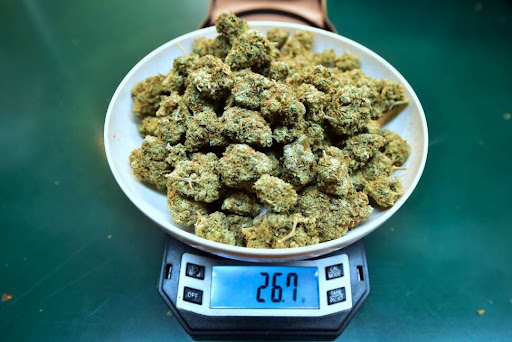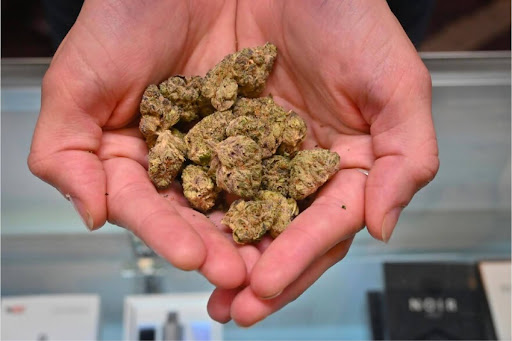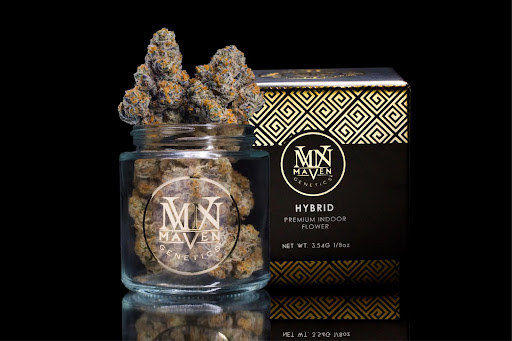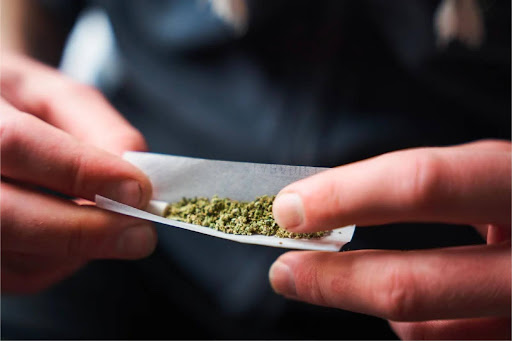An eighth of cannabis flower weighs 3.5 grams and typically costs between $35 and $50. You can expect to roll 3 to 7 joints or pack 7 to 14 bowls from this amount.
For those interested in understanding the intricacies of cannabis measurements, pricing, and how this compares to other quantities, read on for a comprehensive guide to navigating the world of cannabis weights and their value.
Understanding Cannabis Quantities

When purchasing cannabis, understanding weed measurements and weights is essential for both consumers and sellers.
An eighth refers to an eighth of an ounce in terms of weight, a common unit of measurement for cannabis products.
One ounce is equivalent to approximately 28.35 grams; an eighth of an ounce comes to roughly 3.54 grams. For simplicity, the cannabis industry typically rounds down the weight of an eighth to an even 3.5 grams.
How is Weed Measured?

Weed is measured in increments that reflect fractions of an ounce. Typical measurements for cannabis include:
- Gram: the base unit of measurement.
- Eighth: 1/8 of an ounce, or around 3.5 grams.
- Quarter Ounce: 1/4 of an ounce, or 7 grams.
- Half Ounce: 1/2 of an ounce, or 14 grams.
- Ounce: About 28 grams.
Scales determine the weight, ensuring accuracy for transactions. Later in this post, we’ll discuss some of the most common measurements of flowers and how many sessions you can get out of each quantity.
How Much Weed Do I Need?
Determining the right amount of cannabis for personal use can be a nuanced process, as it depends on a few factors unique to the smoker.
These include:
- Individual tolerance levels
- Desired effects one aims to achieve
- How frequently one uses cannabis
For those new to cannabis, we recommend starting with a modest amount in one sitting, like a gram, which can be shared with one or multiple friends.
This is also helpful to gauge your body’s response to a specific weed strain.
Beginners may find that smoking or vaping half-gram joints allows for a manageable experience, enabling them to understand their tolerance and preferences better.
Some strains, especially those known for their high THC content, may require smaller quantities to achieve the desired effect, whereas others with lower THC levels might necessitate a bit more.
Regular reflection on your experiences with different quantities and strains will help fine-tune your understanding of what works best for you.
Why an Eighth is So Popular?

An eighth of cannabis, equivalent to 3.5 grams, is one of the most popular quantities sold. It strikes a balance between affordability and quantity, making it a standard choice for regular users.
An eighth allows for a sufficient number of sessions without a significant financial commitment.
If you’re a beginner, you can divide up your flower and have plenty for multiple smoking sessions, even with friends.
Or, if you’re a more experienced smoker, you’ll still have more than enough for a few big bowls or joints.
Common Quantities, Costs, How Many Joints, and How Many Bowls
Below is a table that outlines common cannabis quantities, approximate costs, and the resultant number of joints or bowls one might expect:
| Quantity (Grams) | Approx. Cost (USD) | Number of Joints* | Number of Bowls** |
| 1 (Gram) | $10 – $15 | 1 – 2 | 2 – 3 |
| 3.5 (Eighth) | $35 – $50 | 3 – 7 | 7 – 14 |
| 7 (Quarter) | $70 – $100 | 7 – 14 | 14 – 28 |
| 14 (Half) | $120 – $180 | 14 – 28 | 28 – 56 |
| 28 (Ounce) | $230 – $350 | 28 – 56 | 56 – 112 |
*Assuming .5 grams per joint **Assuming .25 grams per bowl
This table is a rough estimate and actual numbers may vary based on joint and bowl sizes, and local market prices.
What does an eighth look like?
Some flower is dense and moist, while other cannabis strains have fluffy, airy buds. For that reason, there’s no standard “look” to an eighth.
Generally speaking, an eighth can be visualized as a small handful of buds that could fill approximately half to three-quarters of a standard-sized plastic bag used in dispensaries.
Average Costs of an Eighth

The average price of an eighth of cannabis varies widely based on several factors, including regional market conditions, quality, and legal status.
Factors Affecting Cannabis Cost
- Regional Variations: Prices can fluctuate greatly depending on the state or country’s local laws and supply chain efficiencies.
- Quality and Potency: Higher quality strains with increased potency typically demand a higher price point.
Legal Status: Cannabis prices tend to be higher in regions where it is legalized due to taxes and regulatory costs.
Typical Price Ranges for an Eighth
Quality Average Cost USD Low-end or “budget” cannabis $20 – $30 Mid-tier quality $30 – $40 Top-shelf or premium quality $40 – $60
These figures are representative of the average costs an individual might encounter when purchasing an eighth of cannabis (3.5 grams) in a market where the substance is legal. Prices will vary and may fall outside these ranges based on the aforementioned factors.
Buying in Bulk vs. Small Quantities

When purchasing cannabis, buying in bulk can lead to cost savings, as many dispensaries and sellers offer price breaks for larger quantities.
For instance, while the price for a single gram might range from $10 to $15, one eighth can cost between $30 to $50, translating to a lower cost per gram. Here is an illustrative price comparison table:
Quantity Average Price Range 1 gram $10 – $15 1 eighth $30 – $50 1 ounce $200 – $300
Under optimal storage conditions—cool, dark, and dry, with minimal exposure to air—cannabis flower can maintain its potency for about 6 months to a year before starting to degrade significantly.
Proper storage involves keeping the flower in an airtight container made of glass or metal, away from direct sunlight and extreme temperatures.
When cannabis begins to lose its potency, the THC (tetrahydrocannabinol) gradually breaks down into CBN (cannabinol), which has different effects and is less psychoactive.
Additionally, the terpenes that contribute to the flower’s aroma and flavor can evaporate, diminishing the overall sensory experience.
That’s why weed delivery services are so handy! If you live in the greater Central Valley area, we’d love to deliver your next eighth.
7 Points is dedicated to bringing the best cannabis experience possible straight to your doorstep. We carry hundreds of products on our menu and boast holding some of the best brands in the state.Click here to browse our selections and place an order. We’re looking forward to delivering to you soon!
FAQs about Weed Quantities
Slang terms for weed quantities vary by region but commonly include “dime” (a small amount, typically $10 worth), “dub” ($20 worth), “eighth” (3.5 grams, or an eighth of an ounce), “quarter” (7 grams, or a quarter of an ounce), “half” (14 grams, or a half-ounce), and “zip” or “ounce” (28 grams).
These terms help users and sellers quickly reference specific amounts without using precise measurements.
The cost of a half (half an ounce, or 14 grams) can vary widely depending on the quality of the weed, the region, and the current market demand. Generally, prices can range from $90 to $160, but this is highly subject to change based on the aforementioned factors.
A quarter ounce typically includes 7 grams of cannabis. This quantity is sufficient for those who consume moderately or want to have a stash that allows for variety without committing to a larger, more costly amount. It’s a popular choice for regular users looking for a balance between cost and convenience.
Weed weight can vary depending on several factors, including the density and moisture content of the cannabis flowers.
Denser buds will weigh more but may not necessarily indicate higher quality. Properly cured cannabis will have an optimal moisture content that preserves terpenes and cannabinoids without being too dry or too moist, which can also affect the weight.
Cannabis shops ensure product quality through a variety of methods, including sourcing from reputable growers, conducting lab tests for potency and contaminants, and maintaining proper storage conditions to preserve freshness, potency, and safety.
Many regions have specific regulatory requirements for testing and quality assurance that shops must follow.
Yes, the density and moisture content of cannabis significantly affect its quality. Optimal moisture content is crucial for preserving the integrity of the cannabinoids and terpenes, which contribute to the effects and flavor profile of the cannabis.
Too much moisture can lead to mold and mildew, while too little can degrade the terpenes and cannabinoids, diminishing the overall quality and experience. Density can indicate the cultivation quality, with denser buds often being more desirable, though this is not a sole indicator of overall weed cost and quality.



